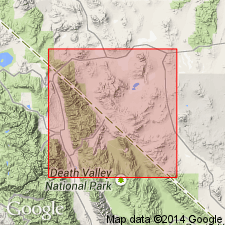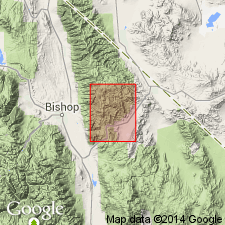
- Usage in publication:
-
- Saline Valley Formation
- Modifications:
-
- Named
- AAPG geologic province:
-
- Great Basin province
Summary:
Pg. 140 (fig. 2), 142, 143. Saline Valley Formation. In type section, basal member is composed of medium- to coarse-grained quartzitic sandstone, locally becomes vitreous quartzite, capped by persistant blue-gray arenaceous limestone. Upper member is succession of quartzitic sandstone, limestone, and gray-green and black shale. Thickness 850 feet. Overlies Harkless Formation (new); underlies Mule Spring Formation (new). Eastward to area of Magruder Mountain and Goldfield, Nevada, the Saline Valley as a formational unit is missing. Age is Early Cambrian.
Named from exposures [type section] along the Waucoba Spring section, overlooking Saline Valley to the south. The Waucoba section is that described by Walcott (1908, Smithsonian Misc. ColIn., v. 53, no. 5) east of Waucoba Springs, on Saline Valley Road, east of Inyo Range, Wacoba Spring 15-min quadrangle, Inyo Co., CA.
Source: US geologic names lexicon (USGS Bull. 1350, p. 658-659).

- Usage in publication:
-
- Saline Valley Formation*
- Modifications:
-
- Adopted
- AAPG geologic province:
-
- Great Basin province
Summary:
Saline Valley Formation of Nelson (1962) is adopted. Age is Early Cambrian.
Source: GNU records (USGS DDS-6; Menlo GNULEX).
For more information, please contact Nancy Stamm, Geologic Names Committee Secretary.
Asterisk (*) indicates published by U.S. Geological Survey authors.
"No current usage" (†) implies that a name has been abandoned or has fallen into disuse. Former usage and, if known, replacement name given in parentheses ( ).
Slash (/) indicates name conflicts with nomenclatural guidelines (CSN, 1933; ACSN, 1961, 1970; NACSN, 1983, 2005, 2021). May be explained within brackets ([ ]).

